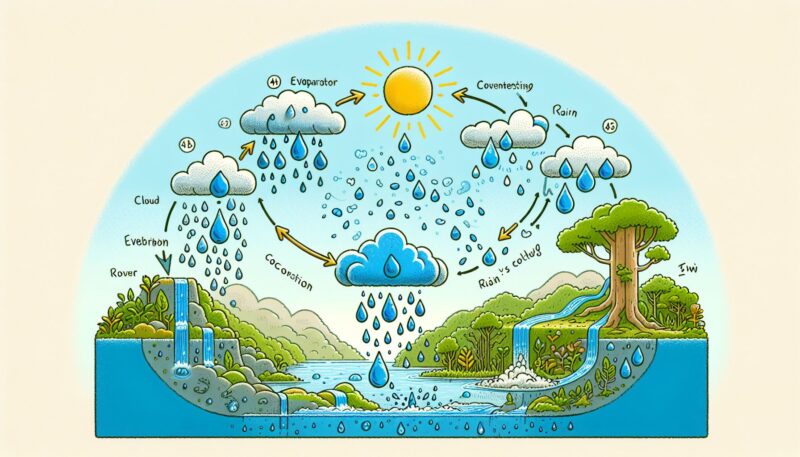Water is the essence of life, the backbone of ecosystems, and a pivotal force shaping our planet’s future. At the heart of the water dynamics on Earth is the hydrologic cycle, a complex and continuous movement of water within the hydrosphere, encompassing oceans, land, and atmosphere.
Understanding the Hydrologic Cycle
The hydrologic cycle is the natural process that recycles water on our planet. It’s a continuous exchange involving various stages including evaporation, transpiration, condensation, precipitation, infiltration, percolation, and runoff. Each stage plays a vital role, influencing climate systems, shaping geological landscapes, and sustaining life in myriad forms.
Evaporation: The Ascending Beginnings
Evaporation marks the journey of a raindrop from the Earth’s surface as it transforms from liquid into vapor. The sun’s energy acts as the catalyst, providing the warmth needed for water in oceans, rivers, and lakes to overcome molecular bonds and rise into the air. Plants also contribute to this voyage through transpiration, where water absorbed by roots escapes as vapor from their leaves.
Transpiration: Nature’s Respiration
Transpiration, often linked closely with evaporation, is the process of water movement through plants and its evaporation from aerial parts, like leaves, stems, and flowers. It plays a critical role in the climate system, influencing humidity and cloud formation, and involves an intricate network of water transport in plant tissues.
Condensation: The Transformation Back to Liquid
As water vapor rises and cools in the upper atmosphere, it undergoes condensation, forming tiny droplets that clothe our skies in clouds. This stage is the prelude to precipitation, as these droplets coalesce into larger ones, eventually becoming heavy enough to fall back to Earth due to gravity.
Precipitation: Return to the Surface
Precipitation occurs in various forms—rain, snow, sleet, or hail—depending on the atmospheric conditions. It replenishes our freshwater sources and is a key element of the hydrologic cycle, providing the necessary hydration for ecosystems to thrive.
Infiltration and Percolation: Earth’s Natural Filtering System
Upon reaching the ground, some of the water begins its descent through the soil in a process known as infiltration. Successful infiltration depends on soil composition and land cover. The filtered water, rich in nutrients, trickles down through layers of earth in a movement termed percolation. This water eventually replenishes groundwater supplies and contributes to the flow of streams and rivers.
Runoff: The Travels Across the Land
Water that does not infiltrate the soil becomes runoff. This is the movement of water, usually from precipitation, that flows across the land’s surface and collects in puddles, lakes, rivers, and eventually oceans. This process is heavily impacted by the topography, vegetation, and weather patterns of the area.
Streamflow and Baseflow: Lifelines of the Landscape
Streamflow describes the flow of water in streams and rivers, which can be from surface runoff, precipitation directly falling into the water body, or from baseflow, the sustained contribution of groundwater feeding into the rivers. The interaction between surface and subsurface water systems is vital for maintaining river ecosystems, particularly during dry periods.
Groundwater: The Hidden Treasure
Groundwater is the fresh water found beneath the Earth’s surface in soil pore spaces and in the fractures of rock formations. It is a major source of drinking water and supports river flows, wetlands, and ecosystems, playing a critical role in sustaining life during dry spells.
Aquifers, Recharge, and Discharge: A Balancing Act
An aquifer is an underground layer of water-bearing permeable rock or materials such as gravel, sand, or silt. Groundwater is stored and flows through these natural reservoirs. The recharge occurs when water from the surface soaks into the ground and reaches the aquifer, while the discharge happens when water is removed or naturally flows out of the aquifer to springs, rivers, or the ocean.
The Watershed: A Confluence of Hydrologic Processes
A watershed, or drainage basin, is the land area from which water drains toward a common waterway in a natural basin. All the hydrologic processes mentioned occur within these boundaries. From a tiny creek to a mighty river, every drop of water is on a journey, traveling through various stages of the hydrologic cycle while maintaining the balance of the watershed’s health.
Human Impact and the Hydrologic Cycle
Human activities, like deforestation, urban development, and agriculture, dramatically alter the components of the hydrologic cycle. For instance, the impervious surfaces in cities increase runoff, reducing infiltration, which can lead to increased flooding and decreased groundwater recharge. Conversely, irrigation practices in agriculture can increase recharge in certain areas at the expense of depleting surface water sources.
The Significance of Water Management
Proper management of our water resources, with an understanding of the hydrologic cycle, is crucial to ensure sustainability. Practices such as rainwater harvesting, greywater reuse, and water conservation techniques can mitigate the negative impacts of human activities. These efforts help maintain a balanced hydrologic cycle, which is pivotal in preserving water quality, promoting water security, and adapting to the effects of climate change.
Conclusion
Understanding the intricacies of the hydrologic cycle is imperative for sustaining life on our planet. From the smallest droplet to the vast oceans, the seamless journey of water shapes our world in profound ways. As we embrace better water management and conservation practices, we contribute to maintaining the health and balance of this incredible, life-giving cycle.
Sources:
- United States Geological Survey (USGS) – The Water Cycle: water.usgs.gov/edu/watercycle.html
- Environmental Protection Agency (EPA) – The Hydrologic Cycle and Society: epa.gov/water-research/hydrologic-cycle-and-society
With our collective action, and by honoring the natural flow of Earth’s water, we move towards a more sustainable and thriving future for all.
